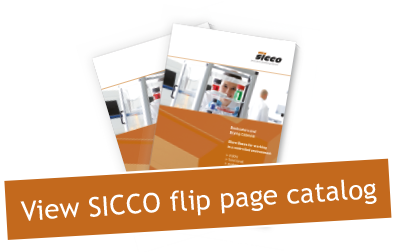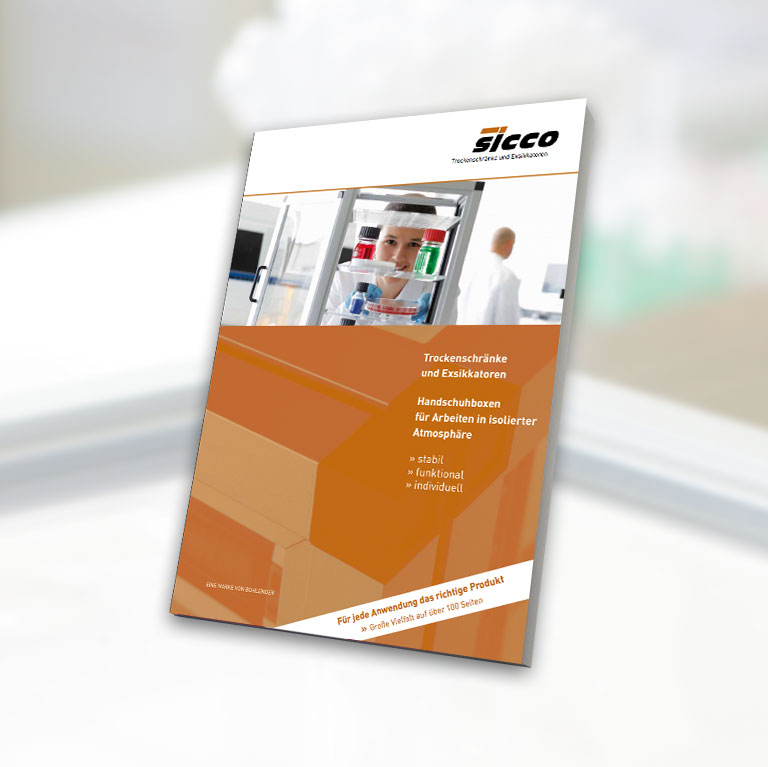Materials at a glance
PMMA
coll: acrylic glass, also known under the tradename Plexiglas® of company Evonik Röhm GmbH synthetic, thermoplastic material; Break proof and impact resistant; Very good surface; shiny;
Good resistance to dilute acids and alkali, limited resistance to organic solvents; Flammable properties similar to hardwood; Very low production of smoke if burnt; Gases ermitted when burning are neither toxic nor corrosive.
- Usuable up to approx. +70 °C
- Volume resistivity: >1015 Ω/cm, test specification DIN VDE 0303
- Surface resistivity: 5 x 10^13 Ω, test specification DIN VDE 0303, part 3
- Transmittance tD65: ~92 %, test specificationDIN 5036, part 3
PMMA orange
Properties: see above;
- tD65 = transmittance accordint to DIN 5036 at standard illuminant D65 (daylight approx. 6500 K, DIN 5033): 42 %
- aD65 = absorbance according to DIN 5036: 52 %
PC
Polycarbonates are plastics that belong to the group of synthetic polymers and to the family of polyesters. Polycarbonates are transparent and non-coloured but they can easily be coloured. The material is characterized by its high stability, impact resistance, stiffness as well as its rigidity. Polycarbonates are widely resistant against atmospheric conditions and radiation. They’re flammable but can easily be extinguished by erasing the source of ignition. Moreover polycarbonates are good isolators. They’re water resistant, resistant against many mineral acids and hydrous solutions of neutral salts and oxidants. Also some other non-polar organic solvents like carbon hydride and many oils and fat do not cause any damage to polycarbonates. However polycarbonates aren’t resistant against chlorinated carbon hydrides, e.g. dichloromethane. It is also instable against hydrous alkaline solutions, amines and ammonia.
PC ESD
PC-ESD is made of transparent, two side coated permanent static dissipative material. The dissipative property reduces particle attraction and the generation of electrostatic fields. Complies with EN 61340-5-1 and ANSI/ESD S20.20-1999
Borosilicate glass
is crystal-clear, non-coloured and shows no significant absorption in the visible spectrum. The permeability of ultraviolet radiation allows it to use the products for photochemical reactions. The refraction index is at 1,472 (with 589,3 nm) and the photoelastic constant is B 3,6 10-6 MPa- 1. The physical properties of borosilicate glass are described in norm DIN ISO 3585. Borosilicate glass has a high chemical resistance against alcohols, water and acids and their mixtures, as well as chlorine, iodine, bromine. The interaction of water only has a small effect on the glass. A thin layer of fused quartz is built up which reduces a further attack on the glass.
- Water resistance (ISO 719) Water classification 1
- Acid resistance (ISO 1776 Acid classification 1-2
- Alcali resistance (ISO 695) Alcali classification 2
Aluminium
This metal stands out due to its very low density of 2,7 g/cm³ (approx. 3 times lighter than steel) and is especially used for the frame and shelves. Aluminium is very reactive right after being machined and therefore reacts with the substances of the surrounding environment, air and humidity, which covers the material with a protective oxide layer. This oxide layer prevents a further corroding of the aluminium but is dissolvable in acids and bases. Thus a direct contact with chemicals should be avoided.
Stainless Steel
Stainless steel is often used for the production of shelves, plates, collecting or protective trays which are an additional protection against leakage. Compared to plastics this material has a very good thermal conductivity. The high corrosion resistance can be generated by means of a nickel alloy. Stainless steel is not only suitable for the use with food but also for applications in the sectors pharmaceutical and biotechnology. In order to avoid an unwanted reaction with metal ions stainless steel should not get in contact with high purity chemicals of the semiconductor industry.
Silicagel
Silicagel is a colourless amorphous silicic acid with a gel-like consistency. It has a large inner surface area. It is very hygroscopic and can be used as gelling agent, filtering or absorption material and desiccant. Normally coupled with an indicator, Silicagel changes colour as soon as it absorbs water; the gel remains pourable and dimensionally stable even in saturated condition. It can be regenerated on a metallic sieve or on a baking tray at approx. 90–110 °C (a microwave oven is not suitable for regeneration!).
EPDM Cellular rubber (Ethylene-Propylene-Diene-Rubber)
This smooth product is used for example for the sealing tape of desiccator doors. It is produced in a so-called expansion manufacture and shows cells in the inside of the product which are not connected. That is why components or sealings made of a primary product through cut out do not lose their capability of sealing. EPDM Cellular rubber is extremely light-weight with a density of approx. 0,13g/cm³ and an excellent thermal insulator through its low thermal conductivity of approx. 0,04 W/m x K. The service temperature is limited from -40 °C to +100 °C (temporary 120 °C). It is resistant to many acids and bases in common concentrations, potassium and sodium combinations (such as saline solution), aqueous alum, detergents, photographic chemicals, cold ammonia, acetylene, alcohols, glycolbased antifreeze fluids and ozone respectively silicone oil. It is not resistant to hydrocarbons (oils, greases, petrol), chlorinated hydrocarbons such as methylene chloride or carbon tetrachloride as well as nitro compounds and concentrated nitric or hydrochloric acids.
Natural Silicone
This elastomer with very good permanently elastic properties is characterized by a wide range of applications. It is used as a neutral netting alkoxy-based 1K-Silicone grease and sealing compound for sealing plastic and glass panels, cable lead-ins and the Iris Port openings. The compatibility with strainless acrylic glass can be confirmed. During curing process small quantities of alcohol can be released. Therefore, a good ventilation has to be provided during treatment. Through interaction of the cured natural silicone with liquid or gaseous chemicals such as iodine, bromine or aldehyde containing substances, the sealing compound can change color. If necessary, experiments have to be made beforehand.
Dischargeable silicone
It is used for the sealing of discs, for sealing of cable lead-ins or the Iris Port openings and more applications where electrostatic discharging is required. The discharge capability is achieved through addition of sooty particles. The specific contact resistance ρ as per DIN EN ISO 3915 (1999) is approx. 0,25 Ω x cm. During curing process small quantities of oxime connections can be released. Therefore, a good ventilation has to be provided during treatment. If the applicator uses materials which will be afterwards treated with dischargeable silicone, he should clarify beforehand that its contents do not change the product (color for example).
NR Natural Rubber (Polyisoprene)
“Natural Rubber” (NR) is used for gloves and other products with high-elastic properties. NR is the basic product of rubbers and is supplemented by silicone elastomers which are characterized by good elasticity at low temperatures, or by fluorine elastomers (FKM) or perfluorelastomers (FFKM) which are especially used at high temperatures or in direct contact with aggressive chemicals. NR is resistant to high-energy radiation. That is why the products made of this material can be gamma-sterilized and are suitable for food, pharma and nuclear industries. Alternatively, it can be sterilized in an autoclave at 120°C for preparation of sterile products. NR loses its elasticity at temperatures < -40 °C. The maximum operating temperature should not exceed +80 °C. Thanks to its resistance to alcohols, acids and bases, NR is widely applicable.
Dischargeable EPDM (Etyhlene-Propylene-Diene-Rubber)
This synthetic rubber is used in dischargeable versions of products which contain sooty particles such as gloves. They are used if an electrostatic charging should be avoided in case of contact. Therefore it is especially suitable for the use in ex-protected applications (contact resistance 4,8 *104 Ω * cm, DIN EN 1149-2, fulfils ATEX requirements) respectively in electronic industries. The contents are conform to current FDA positive list. They are valid as per the criteria of the pharmaceutical, medical and food markets. Dischargeable EPDM is suitable for repeated steam sterilization without sticking. However, the maximum possible operating temperature must not be exceeded. EPDM loses its elasticity at temperatures < -20 °C. The maximum operating temperature should not exceed +130 °C. The material is free of halogen and resistant to many oxidizing media.
Black glass fibre reinforced PA
This glass fibre reinforced thermoplast is mainly used for corner connections, hinges or rails. Due to its high rigidity glass fibre reinforced PA is preferably used for all kinds of structural parts. Because of the additional stabilisation the material has a very high hydrolysis resistance at a continuous service temperature of 130°C and also has a good resistance against most acids. Nonetheless the material should not get in contact with hydrofluoric acid or moderate respectively strong leaches. Furthermore glass fibre reinforced PA stands out due to its excellent insulation properties. A direct contact with open flames should be avoided due to the given combustibility.
Natural PP
Gas-saving valves or cable lead-ins are products made of natural PP. The thermoplastic processable Polypropylene has a high hardness and stiffness, is insensitive to stress cracking and shows a better resilience. However low temperatures restrict the ductility. The continuous service temperature is +110°C, a temporary operation at a temperature of +140°C is possible. Natural PP is combustible and thus should not get in direct contact with open flames. The material is resistant against aqueous solutions of inorganic salts as well as most inorganic acids and leaches, even at higher concentrations and temperatures up to 60°C. Natural PP is affected by oxidizing chemicals such as oleum, concentrated nitric acid or by halogens.
Black PP
This dyed, non-conductive thermoplastic material is used for Iris-Ports and connectors for exhaust system in the glove box as well as electrical boxes on the Automatic Desiccators. The black pigmentation serves especially for better identification of the plastic parts (e.g. compared with Plexiglas) and does not change the properties of the plastic. Properties and application recommendations correspond therefore to the ones of natural PP. The black color can change respectively completely disappear in case of contact with chemicals.
Conductive PE
By addition of sooty particles, Polyethylene gets electro-conductive properties. The particles avoid electrostatic charging. Although this material shows conductive properties (spec. surface resistivity < 106 Ohm, DIN EN 60093, fulfils ATEX requirements), they are significantly lower than those of metals (spec. surface resistivity < 1 Ohm). Conductive PE is used for example for shelves of Mini Desiccators or for Conductive Cable lead-ins. As the material has a temperature application area from -20°C to +80 °C, its applications are limited to “extended room temperature”. The material is flammable and should not come into contact with open flames.
White PBTP
A typical application for this thermoplastic Polybutylenterephtalate (PBTP) material are Silica Gel Trays in laboratories. It is characterized by a low moisture absorption (0,2 - 05 percent by weight), a high mechanical strength, shock resistance due to good impact strength and very good electrical insulation properties (spec. contact resistance > 1013 Ohm x cm). Trays made of natural PBTP retain their shape up to approx. +165 °C. The material is flammable and should, therefore, not come into contact with open flames. It is resistant to diluted acids and bases at ambient temperature, alcohols, hydrocarbons, ketones, ether, mineral oils, fuels and saline solutions.





